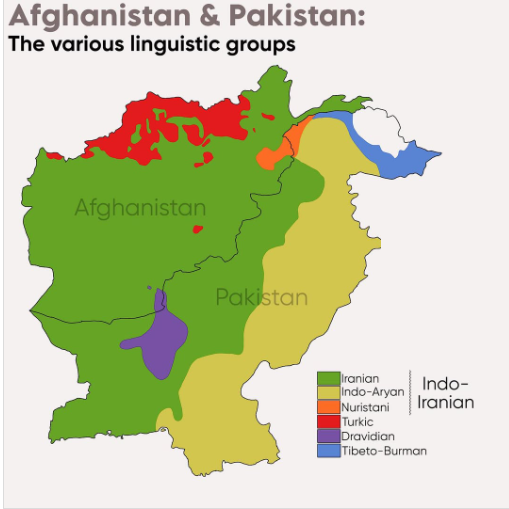Linguistic Groups of Pakistan and Afghanistan Map


Marcus Rodriguez
Historical Geography Expert
Marcus Rodriguez specializes in historical cartography and geographic data analysis. With a background in both history and geography, he brings unique...
Geographic Analysis
What This Map Shows
The "Linguistic Groups of Pakistan and Afghanistan Map" provides a detailed visualization of the diverse languages spoken across these two culturally rich countries. It highlights the distribution of various linguistic groups, illustrating how language correlates with ethnic and cultural identities. This map serves as a window into the intricate tapestry of communication, tradition, and heritage that shapes the lives of millions in this region.
Deep Dive into Linguistic Diversity
Language is much more than just a means of communication; it is a vital part of cultural identity. In Pakistan and Afghanistan, the linguistic landscape is incredibly varied, reflecting centuries of history, migration, and interaction between different ethnic groups.
In Pakistan, the predominant languages include Urdu, Punjabi, Sindhi, Pashto, and Balochi. Urdu is the national language and serves as a lingua franca, facilitating communication among people from diverse linguistic backgrounds. Interestingly, while Urdu is widely spoken, Punjabi is the most common first language in the province of Punjab, where nearly half of Pakistan's population resides. According to the 2017 census, approximately 44% of the population speaks Punjabi, showcasing its significance in the cultural fabric of the nation.
Pashto, primarily spoken in Khyber Pakhtunkhwa and Balochistan, holds a special place as it is not only a language but also a key component of Pashtun identity. This language has a rich oral tradition and is known for its poetic heritage. Balochi, predominantly spoken in Balochistan, adds another layer to the linguistic diversity, with its own unique dialects and cultural expressions.
On the other hand, Afghanistan is home to a multitude of languages, with Dari and Pashto being the two official languages. Dari, a dialect of Persian, is spoken by about 50% of the population, while Pashto accounts for around 35%. The coexistence of these languages reflects the ethnic mosaic of Afghanistan, where various groups, including Tajiks, Hazaras, Uzbeks, and others, contribute to the rich linguistic heritage. Interestingly, languages like Uzbaki and Turkmen also have a presence in northern Afghanistan, highlighting the multicultural aspect of the nation.
Regional Analysis
When examining the map closely, distinct regional linguistic patterns emerge. In Pakistan, the northern regions, including Gilgit-Baltistan, showcase languages such as Shina and Balti, which are part of the Dardic language family. These languages are not only vital for communication but also serve as carriers of local folklore and traditions.
Conversely, the southern regions of Pakistan, particularly Sindh, are dominated by Sindhi, which has a long literary history and is recognized for its vibrant folk culture. Comparatively, Balochistan stands out with its trilingual population, where Balochi, Pashto, and Urdu coexist, reflecting the province's ethnic diversity.
Moving to Afghanistan, the eastern regions are predominantly Pashto-speaking, while the central and northern areas lean towards Dari. The linguistic divide often mirrors ethnic lines, with Tajiks primarily speaking Dari and Pashtuns favoring Pashto. This division has significant implications for social dynamics and political relationships in the country.
Significance and Impact
Understanding the linguistic groups of Pakistan and Afghanistan is crucial for several reasons. Firstly, language plays a central role in shaping identity and community cohesion. In regions where languages blend, like parts of Balochistan, cultural exchanges flourish, enhancing social harmony. However, in areas where language barriers exist, tensions may arise, making it essential for policymakers to consider linguistic diversity in governance and development strategies.
Moreover, the linguistic landscape reflects the historical narratives of both countries. Language preservation efforts are vital, especially for minority languages at risk of extinction due to globalization and urbanization. For instance, languages such as Shina and Balti in Pakistan are threatened, and initiatives to document and promote these languages can help preserve unique cultural identities.
In conclusion, the linguistic groups of Pakistan and Afghanistan not only enrich the cultural heritage of these nations but also serve as critical elements in understanding their social dynamics. As globalization continues to influence communication patterns, the significance of these languages will evolve, making it imperative to embrace and celebrate this linguistic diversity.
Visualization Details
- Published
- August 16, 2025
- Views
- 202
Comments
Loading comments...